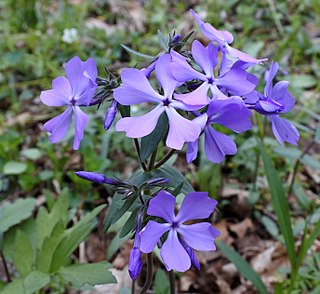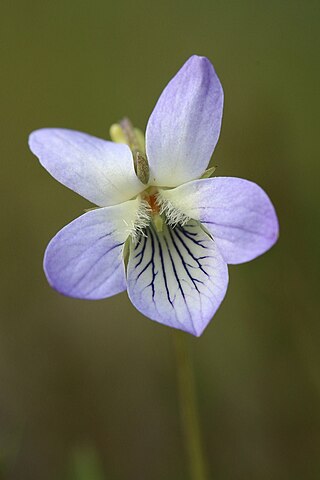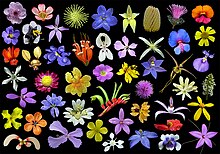
Papaver rhoeas, with common names including common poppy, corn poppy, corn rose, field poppy, Flanders poppy, and red poppy, is an annual herbaceous species of flowering plant in the poppy family Papaveraceae. It is a temperate native with a very wide distribution area, from Africa to temperate and tropical Asia and Europe.

Dianthus is a genus of about 340 species of flowering plants in the family Caryophyllaceae, native mainly to Europe and Asia, with a few species in north Africa and in southern Africa, and one species in arctic North America. Common names include carnation, pink and sweet william.

Fritillaria meleagris is a Eurasian species of flowering plant in the lily family Liliaceae. Its common names include snake's head fritillary, snake's head, chess flower, frog-cup, guinea-hen flower, guinea flower, leper lily, Lazarus bell, chequered lily, chequered daffodil, drooping tulip or, in the British Isles, simply fritillary. The plant is a bulbous perennial native to the flood river plains of Europe where it grows in abundance.

Coreopsis is a genus of flowering plants in the family Asteraceae. Common names include calliopsis and tickseed, a name shared with various other plants.

Viola riviniana, the common dog-violet, is a species of flowering plant in the family Violaceae, native to Eurasia and Africa. It is also called wood violet and dog violet. It inhabits woodland edges, grassland and shady hedge banks. It is found in all soils except those which are acid or very wet.

Eriophorum angustifolium, commonly known as common cottongrass or common cottonsedge, is a species of flowering plant in the sedge family, Cyperaceae. Native to North America, North Asia, and Europe, it grows on peat or acidic soils, in open wetland, heath or moorland. It begins to flower in April or May and, after fertilisation in early summer, the small, unremarkable brown and green flowers develop distinctive white bristle-like seed-heads that resemble tufts of cotton; combined with its ecological suitability to bog, these characteristics give rise to the plant's alternative name, bog cotton.

Coreopsis lanceolata, commonly known as lanceleaf coreopsis, lanceleaf tickseed, lance-leaved coreopsis, or sand coreopsis, is a North American species of tickseed in the family Asteraceae.

Dianthus armeria, the Deptford pink or grass pink, is a species of Dianthus ("pink") native to most of Europe, from Portugal north to southern Scotland and southern Finland, and east to Ukraine and the Caucasus. It is naturalised in North America.

Plains coreopsis, garden tickseed, golden tickseed, or calliopsis, Coreopsis tinctoria, is an annual forb. The plant is common in Canada, northeast Mexico, and much of the United States, especially the Great Plains and Southern states where it is often called "calliopsis". The species is also widely cultivated and naturalized in China.

Stylophorum diphyllum, commonly called the celandine poppy or wood poppy, is an herbaceous plant in the poppy family (Papaveraceae). It is native to North America, where it is found in the eastern United States and Ontario. Its typical natural habitat is moist forests over calcareous rock, particularly in ravines.

Plantlife is a wild plant conservation charity. As of 2023, it manages 24 nature reserves around the United Kingdom. HM King Charles III is patron of the charity.

Polemonium caeruleum, known as Jacob's-ladder or Greek valerian, is a hardy perennial flowering plant. The plant produces cup-shaped, blue or white flowers. It is native to temperate regions of Europe. It is the type species of the phlox family, Polemoniaceae.

Dianthus gratianopolitanus, commonly known as the Cheddar pink or clove pink, is a species of plant in the family Caryophyllaceae. It is a herbaceous perennial, hardy to zones 4–8. It grows to a height of 0.5 to 1 feet, blooming from May to June. Flowers are fragrant and rose pink. Grows best in full sun, and has medium water requirements. Overwatering or poor drainage leads to crown rot, and plants do not tolerate wet winter soil conditions.

Phlox subulata the creeping phlox, moss phlox, moss pink or mountain phlox, is a species of flowering plant in the family Polemoniaceae, native to eastern and central USA, and widely cultivated.

Phlox divaricata, the wild blue phlox, woodland phlox, or wild sweet william, is a species of flowering plant in the family Polemoniaceae, native to forests and fields in eastern North America.

Coreopsis grandiflora is a North American species of perennial plant in the family Asteraceae. The common name is large-flowered tickseed. It is found in eastern Canada and much of the United States, especially the south-central part of the country. The species is widely cultivated in China and naturalized there.

Cyperus fuscus is a species of sedge known by the common name brown galingale, or brown flatsedge. This plant is native to much of Europe, Asia and North Africa from England, Portugal and Morocco east to China and Thailand. It is an introduced species in North America, where it is naturalized in widely scattered locations in the United States and Canada.

Phlox maculata, common names wild sweetwilliam and meadow phlox, is a species of flowering plant in the family Polemoniaceae, native the eastern United States and introduced to eastern Canada. It is a perennial.

Viola lactea, also known by its common name pale dog violet, is a species of flowering planet of the family Violaceae.























